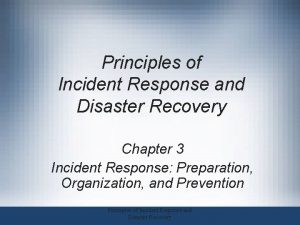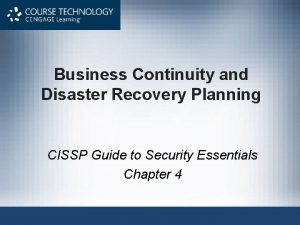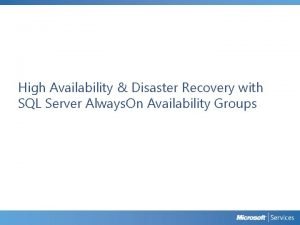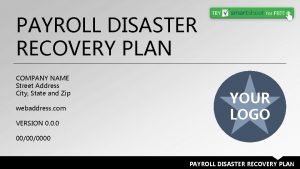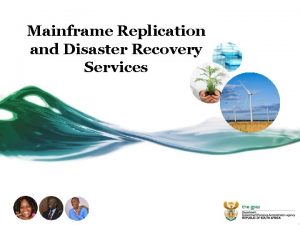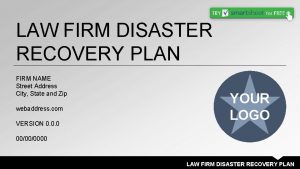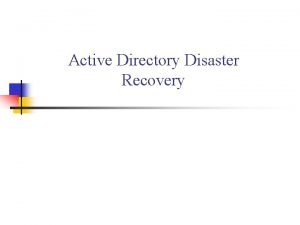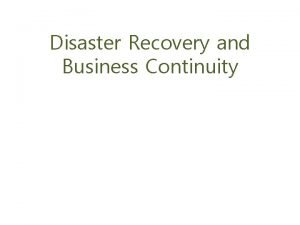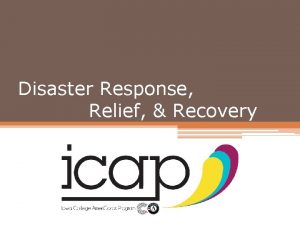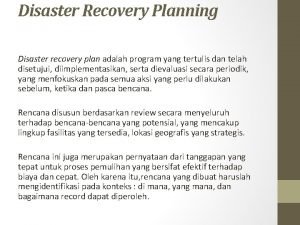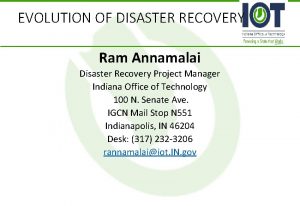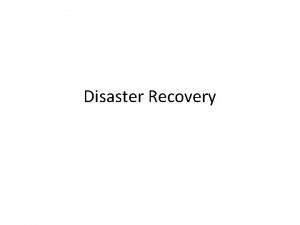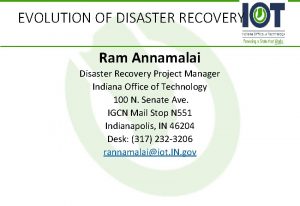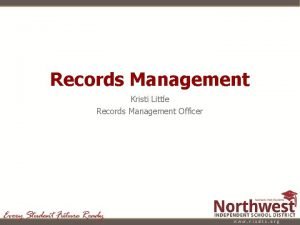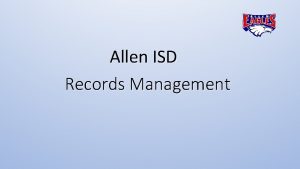Disaster Recovery 1102018 COOP Disaster Recovery and Records

















- Slides: 17

Disaster Recovery 1/10/2018

COOP, Disaster Recovery, and Records Recovery • Continuity of Operations Plan’s purpose is to be prepared to relocated your agency in the event of a long term disaster. • Disaster Recovery refer to the initial steps during or following a disaster to maintain law and order, and the continuity of government. • Records recovery’s focus is maintaining an agencies ability to fulfill its mission.

Steps of Disaster Recovery • • Plan Prepare Respond Recover

Planning • Identify Vital Records • Identify Disaster response team • Locate local contractors to rebuild and repair facilities, equipment and documents • Identify temporary/new facility requirements

Vital Records • Vital records are any record essential to fulfill the mission of your agency. • Know where all of the vital records for your agency are kept. • Make sure that vital records are backup. • If they cannot be backed up take steps to protect them from disaster. • Make sure vital records are accessible for everyone who will need to access them.

Non-Vital Records • Vital Records you will need on day one to continue working. • Identify records you will need within: • 1 Week • 1 Month • 2 Months to 1 Year • Identify where and how these records are stored.

First Response Team • Assign a Lead Disaster Records Coordinators (DRC) to take charge in the event of an incident. • Typically agency/department head • Pick a back up Lead in the event the Lead DRC is unavailable. • Assistant agency head, or anyone who can be counted on to take charge in the event of a disaster • Identify parties that need to be on the first call list. • Department head • On site Facilities manager • Team leads

Outside Resources • DAS Facilities • Contact if a new facility or facility repairs need to be made. • Local Emergency Services • Make sure to have both the emergency and non-emergency numbers for all of the local emergency services • Freezer/Cold Storage • One of the best ways to save wet documents is to freeze them • Professional Consultants • Collect the numbers of Recovery Service consultants • Have the number for any consulting firms or professionals that can provide insight to the recover of your specific agency

Facility Requirements • Know your agencies facility requirements • Minimum square feet your department/agency requires to operate • The number of Computers and any hardware Number of internet/intranet connections • Number of phone lines • Security concerns • Parking (low priority)

Prepare • Create a disaster response plan • Compile a list of names and phone numbers of the • • first action response team, agency staff, and relevant contractors and vendors. Create a recovery/clean up supply list Back up vital records Obtain proper software and permissions to continue work after a disaster Train Staff

Creating a Plan • Compile all of the information from the planning phase • Prioritize each work group within the agency • Include all numbers for: • • First response team All agency staff Vendor and consultants Facility contacts • Distribute the plan • Regular review • Annual or as staff changes

Nebraska Secretary of State Records Management Disaster Recovery Plan • • • Purpose • • • Organizing for response Policy Scope Responsibility Introduction • 7 Steps Business Systems priorities Floor Plans Security Appendices

Respond • Activate the Disaster response team • Make sure everyone is safe • Prevent any further damage to records, equipment, • • or facilities where possible Contact relevant vendors and contractors Contact Agency Staff Recover through backups the ability to continue agency business. Document all steps of the process as they unfold

Recover • Identify which records need attention • • Vital One Week One Month Two Months - 1 year • If needed identify and shift to a new facility • Reestablish network connections • Notify staff when and where to return to work

After Action Report • • Vital to the Document Recovery Process Include all actions taken What worked/what didn’t work Include a complete list of records that were lost to the disaster • Create a record disposition report for these records

Records Managements Seven Steps to Disaster Emergency Response • • Activate First Response Team Establish Safety and Security Stabilize Environment Assess Damage Prioritize Records Treat Records After Action Report

Contact Us • Austin Rhodes RIM Specialist/DISC Supervisor Austin. Rhodes@Nebraska. gov 402 -471 -9778 • Jeanette Greer Records Management Division Manager Jeanette. Greer@Nebraska. gov 402 -471 -2747
 Coop disaster recovery
Coop disaster recovery Records management disaster recovery plan
Records management disaster recovery plan Principles of incident response and disaster recovery
Principles of incident response and disaster recovery Backup and disaster recovery mississippi
Backup and disaster recovery mississippi How often should a business continuity plan be tested cissp
How often should a business continuity plan be tested cissp Socio economic trends
Socio economic trends Sql server high availability and disaster recovery
Sql server high availability and disaster recovery Read-scale availability groups
Read-scale availability groups Principles of incident response and disaster recovery
Principles of incident response and disaster recovery Disaster recovery planning in system analysis and design
Disaster recovery planning in system analysis and design Verizon 140 west street
Verizon 140 west street Payroll disaster recovery plan
Payroll disaster recovery plan Manufacturing disaster recovery
Manufacturing disaster recovery Mainframe disaster recovery
Mainframe disaster recovery Law firm disaster recovery
Law firm disaster recovery Emc disaster recovery
Emc disaster recovery Oracle business continuity plan
Oracle business continuity plan Ad disaster recovery planning scenario
Ad disaster recovery planning scenario


